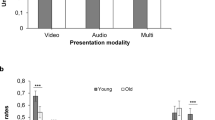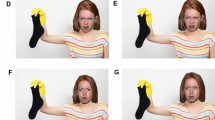Abstract
Older adults tend to perform worse on emotion perception tasks compared to younger adults. How this age difference relates to other interpersonal perception tasks and conversation ability remains an open question. In the present study, we assessed 32 younger and 30 older adults’ accuracy when perceiving (1) static facial expressions, (2) emotions, attitudes, and intentions from videos, (3) and interpersonal constructs (e.g., kinship). Participants’ conversation ability was rated by coders from a videotaped, dyadic problem-solving task. Younger adults were more accurate than older adults perceiving some but not all emotions. No age differences in accuracy were found on any perception task or in conversation ability. Some but not all of the interpersonal perception tasks were related. None of the perception tasks predicted conversation ability. Thus, although the literature suggests a robust age difference in emotion perception accuracy, this difference does not seem to transfer to other interpersonal perception tasks or interpersonal outcomes.
Similar content being viewed by others
Notes
Older adults had worse vision, t(57) = 23.72, p < .01, fewer depressive symptoms, t(53) = 10.29, p < .01, and better mood, t(58) = 18.90, p < .01, than younger adults. No participants reported difficulties viewing text on the computer monitor. Older and younger adults did not differ in fluid intelligence, t(49) = .16, p = .69, nor did they differ on the MMSE, t(51) = 1.24, p = .27; additionally, all participants scored above 26, suggesting a lack of dementia symptoms (Folstein et al. 1975). These patterns are consistent with previous studies finding older adults to have higher positive mood, fewer symptoms of depression, and worse visual acuity (Dulin and Pachana 2005; Lawton et al. 1993; Lawton et al. 1992; Mroczek and Kolarz 1998; Chasteen et al. 2002) as compared to younger adults. All participants were healthy enough to come to the lab unassisted. Differences in the covariates did not predict interpersonal perception or conversation ability.
This finding should be interpreted cautiously as it may be a result of a differing difficulty level between the subgroups of the test and not suggestive of differing accuracy when perceiving certain interpersonal constructs. In other words, the IPT-15 may make it more difficult to perceive deception compared to kinship instead of suggesting that individuals are better at perceiving kinship in everyday interactions.
References
Bänziger, T., Scherer, K. R., Hall, J. A., & Rosenthal, R. (2011). Introducing the MiniPONS: A short multichannel version of the profile of nonverbal sensitivity (PONS). Journal of Nonverbal Behavior, 35, 189–204.
Beaupré, M. G., & Hess, U. (2005). Cross-cultural emotion recognition among Canadian ethnic groups. Journal of Cross-Cultural Psychology, 36(3), 355–370.
Beaupré, M. G., & Hess, U. (2006). An ingroup advantage for confidence in emotion recognition judgments: The moderating effect of familiarity with the expressions of outgroup members. Personality and Social Psychology Bulletin, 32(1), 16–26.
Birditt, K. S., Fingerman, K. L., & Almeida, D. M. (2005). Age differences in exposure and reactions to interpersonal tensions: A daily diary study. Psychology and Aging, 20(2), 330–340.
Borod, J. C., Yecker, S. A., Brickman, A. M., Moreno, C. R., Sliwinski, M., Foldi, N. S., et al. (2004). Changes in posed facial expression of emotion across the adult life span. Experimental Aging Research, 30, 305–331.
Calder, A. J., Keane, J., Manly, T., Sprengelmeyer, R., Scott, S., Nimmo-Smith, I., et al. (2003). Facial expression recognition across the adult life span. Neuropsychologia, 41, 195–202.
Chasteen, A. L., Schwarz, N., & Park, D. C. (2002). The activation of aging stereotypes in younger and older adults. The Journals of Gerontology Series B: Psychological Sciences and Social Sciences, 57(6), 540–547.
Costanzo, M., & Archer, D. (1993). Interpersonal perception Task-15. Center for Media and Independent Learning, University of California Extension.
Dulin, P., & Pachana, N. A. (2005). Older adult mood functioning: Developmental changes and factors associated with positive and negative outcomes. In A. V. Clark (Ed.), Mood State and Health (pp. 175–194). New York: Nova Science.
Ebling, R., & Levenson, R. W. (2003). Who are the marital experts? Journal of Marriage and Family, 65(1), 130–142.
Ebner, N. C., Riediger, M., & Lindenberger, U. (2010). FACES—A database of facial expressions in young, middle-aged, and older women and men: Development and validation. Behavior Research Methods, 42(1), 351–362.
Fiske, S. T., Cuddy, A. J., & Glick, P. (2007). Universal dimensions of social cognition: Warmth and competence. Trends in Cognitive Sciences, 11(2), 77–83.
Folstein, M. F., Folstein, S. E., & McHugh, P. R. (1975). “Mini-mental state”: A practical method for grading the cognitive state of patients for the clinician. Journal of Psychiatric Research, 12(3), 189–198.
Hall, J. A., Andrzejewski, S. A., & Yopchick, J. E. (2009). Psychosocial correlates of interpersonal sensitivity: A meta-analysis. Journal of Nonverbal Behavior, 33(3), 149–180.
Hess, T. M., & Auman, C. (2001). Aging and social expertise: The impact of trait-diagnostic information on impressions of others. Psychology and Aging, 16(3), 497–510.
Johnson, D. W. (1975). Cooperativeness and social perspective taking. Journal of Personality and Social Psychology, 31(2), 241–244.
Krendl, A. C., & Ambady, N. (2010). Older adults’ decoding of emotions: Role of dynamic versus static cues and age-related cognitive decline. Psychology and Aging, 25(4), 788–793.
Lambrecht, L., Kreifelts, B., & Wildgruber, D. (2012). Age-related decrease in recognition of emotional facial and prosodic expressions. Emotion, 12(3), 529–539.
Lawton, M. P., Kleban, M. H., & Dean, J. (1993). Affect and age: Cross-sectional comparisons of structure and prevalence. Psychology and Aging, 8(2), 165–175.
Lawton, M. P., Kleban, M. H., Rajagopal, D., & Dean, J. (1992). Dimensions of affective experience in three age groups. Psychology and Aging, 7(2), 171–184.
Lopes, P. N., Salovey, P., Côté, S., Beers, M., & Petty, R. E. (2005). Emotion regulation abilities and the quality of social interaction. Emotion, 5(1), 113–118.
Mroczek, D. K., & Kolarz, C. M. (1998). The effect of age on positive and negative affect: A developmental perspective on happiness. Journal of Personality and Social Psychology, 75(5), 1333–1349.
Murphy, N. A., & Isaacowitz, D. M. (2010). Age effects and gaze patterns in recognising emotional expressions: An in-depth look at gaze measures and covariates. Cognition and Emotion, 24(3), 436–452.
Ngo, N., & Isaacowitz, D. M. (2015). Use of context in emotion perception: The role of top-down control, cue type, and perceiver’s age. Emotion, 15(3), 292–302.
Noh, S. R., & Isaacowitz, D. M. (2013). Emotional faces in context: Age differences in recognition accuracy and scanning patterns. Emotion, 13(2), 238–249.
Orgeta, V., & Phillips, L. H. (2008). Effects of age and emotional intensity on the recognition of facial emotion. Experimental Aging Research, 34, 63–79.
Ruffman, T., Halberstadt, J., & Murray, J. (2009a). Recognition of facial, auditory, and bodily emotions in older adults. The Journals of Gerontology Series B: Psychological Sciences and Social Sciences, 64(6), 696–703.
Ruffman, T., Henry, J. D., Livingstone, V., & Phillips, L. H. (2008). A meta-analytic review of emotion recognition and aging: Implications for neuropsychological models of aging. Neuroscience and Biobehavioral Reviews, 32(4), 863–881.
Ruffman, T., Murray, J., Halberstadt, J., & Taumoepeau, M. (2010). Verbosity and emotion recognition in older adults. Psychology and Aging, 25(2), 492–497.
Ruffman, T., Sullivan, S., & Dittrich, W. (2009b). Older adults’ recognition of bodily and auditory expressions of emotion. Psychology and Aging, 24, 614–622.
Schlegel, K., Boone, R. T., & Hall, J. A. (2017). Individual differences in interpersonal accuracy: A multi-level meta-analysis to assess whether judging other people is one skill or many. Journal of Nonverbal Behavior, 41(2), 103–137.
Spitzberg, B. H., & Hurt, H. T. (1987). The measurement of interpersonal skills in instructional contexts. Communication Education, 36(1), 28–45.
Sullivan, S., & Ruffman, T. (2004). Emotion recognition deficits in the elderly. International Journal of Neuroscience, 114(3), 403–432.
Sze, J. A., Gyurak, A., Goodkind, M. S., & Levenson, R. W. (2012). Greater emotional empathy and prosocial behavior in late life. Emotion, 12(5), 1129–1140.
Vicaria, I. M., Bernieri, F. J., & Isaacowitz, D. M. (2015). Perceptions of rapport across the life span: Gaze patterns and judgment accuracy. Psychology and Aging, 30(2), 396–406.
Wong, B., Cronin-Golomb, A., & Neargarder, S. (2005). Patterns of visual scanning as predictors of emotion identification in normal aging. Neuropsychology, 19(6), 739–749.
Author information
Authors and Affiliations
Corresponding author
Rights and permissions
About this article
Cite this article
Murry, M.W.E., Isaacowitz, D.M. Age Similarities in Interpersonal Perception and Conversation Ability. J Nonverbal Behav 42, 101–111 (2018). https://doi.org/10.1007/s10919-017-0265-0
Published:
Issue Date:
DOI: https://doi.org/10.1007/s10919-017-0265-0




